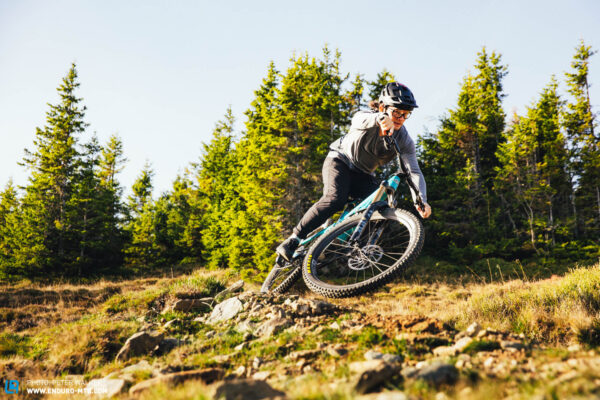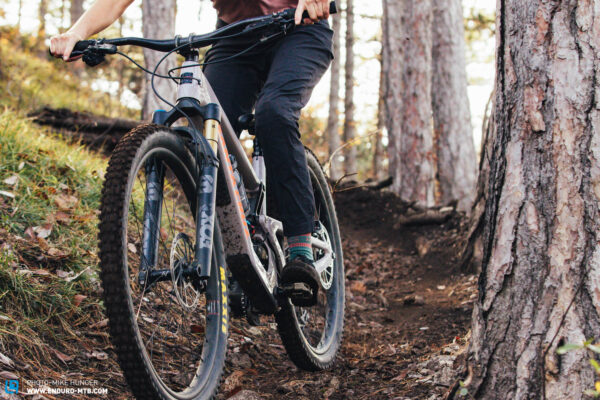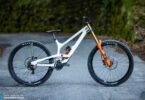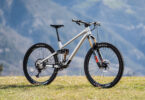Spec lists, geo tabs and kinematics charts tell you just as much about a bike as a Tinder profile tells you about your next date. While data sheets might give you a rough idea about the orientation of a bike, they’ll never tell you how a bike actually rides out on the trail. To help you decide which enduro bike suits you best, we’ve summarised the 7 most important findings from our big 2023 enduro bike group test.
After putting the bikes through the wringer in our big 2023 group test, we looked beyond the obvious to collect the most important findings, identify the hottest trends of the year and draw our conclusions. Read the article to find out everything about the latest generation of enduro bikes and what their future looks like.


Diva or easy going – handling is your closest companion
Handling is something you can’t ignore when riding a bike, especially downhill. Whether you’re drifting through flat corners, negotiating high-speed sections or threading your way through tricky hairpin switchbacks, intuitive and predictable handling makes all the difference, especially when riding at the limit of your bike or your ability. An integrated riding position and even weight distribution between the front and rear are key elements in this equation, allowing you to shred your way back into the valley safely and with as little extra physical effort as possible. Bikes like the Canyon Strive CFR and MERIDA ONE-SIXTY 8000 are easy to ride in all situations, inspiring huge amounts of confidence while at the same time allowing you to ride fast, even after a long day in the saddle. Conversely, bikes like the Mondraker Carbon Foxy RR and Santa Cruz Megatower CC X01 AXS, require an active, vigilant riding style and systematic weight shifts to keep the wheels tracking and hold your line. As a result, they’re more demanding and require an experienced rider but can be extremely fast and fun, provided they end up in the right hands. However, handling isn’t something you can determine based on geometry values, and has to be experienced on the trail. The two Santa Cruz bikes in this test prove just that, sharing near identical geometry and spec, but delivering a completely different riding experience with very distinct temperaments. Electric enduro bikes, like the Yeti 160E T1, have also proven extremely beginner-friendly for mountain bikers, with the high system weight and low centre of gravity ensuring additional traction and stability.

Grip or Slip – Ground control is key
The choice of tires, rubber compounds and casings has a big influence on a bike’s handling. Sure, we could use the same tire model across the entire test field to ensure even more consistent conditions. But tires don’t just end up on a bike, manufacturers (or their product managers) must choose them for a reason – and that’s something we want to find out too! Nevertheless, we didn’t miss the opportunity to swap around tires during this test, above all to give you useful tuning tips. Tires are a relatively cheap upgrade and wear out sooner or later, so you’ll have to change them anyway at some point. While you’re at it, you might as well spend your hard-earned cash wisely and buy a set of tires that suits the character of the bike and your personal preferences. Tires play a crucial role in this respect, because a robust casing allows you to run lower pressures without compromising puncture protection. Lower pressures generally allow for more grip, as the tire can deform around roots and rocks rather than bouncing over them. This also makes for a more damped ride feel and filters out the small trail chatter. Finally, a soft rubber compound generates more traction and is a particularly good choice at the front, where wear and rolling resistance aren’t as big of an issue.


Size is relative – are shorter chainstays really better?
Chainstay length is considered to be a major indicator of the character of a bike. However, handling never depends on a single measurement but the interplay between different values. In other words, it’s all about the right balance between the front and rear triangle. Our Best in Test, the Yeti SB160 T3, has 441 mm chainstays in size L, which harmonises perfectly with its 485 mm reach. Moreover, Yeti adapt the chainstay length to the respective frame size, ensuring consistent handling across all sizes. If the chainstays are too short relative to the reach, you may end up seated too far back over the rear wheel, which will inevitably cause the shock to sink deep into its travel and force you to shift your weight over the front wheel to keep it tracking. At the other extreme, excessively long chainstays can make the bike feel unresponsive and glue the front wheel to the ground. For this reason, choosing your bike based on isolated geometry values, i.e. the shortest possible chainstays, is risky and, quite frankly, pointless. Quite interestingly, the Santa Cruz Nomad, which has a smaller 27.5″ rear wheel and would therefore allow for even shorter chainstays, has longer chainstays than the Santa Cruz Megatower despite sharing the same front triangle as its racing counterpart. This clearly shows that Santa Cruz put their focus on balance instead of blindly following modern geometry trends.

Shopping or riding? – The spec must suit the bike’s character
The build quality, service life and maintenance costs of a bike should play a major role in your purchase decision. After all, our reader survey told us that most of you own your bike for 3 years on average. Sometimes a component that might sound “better” on the spec sheet might not be as suitable as a heavier, less exciting one out on the trail. That said, as far as specs go, things have improved compared to last year’s enduro group test, with an increasing number of manufacturers relying on cool, robust component combinations with bomb-proof parts, big brake rotors and sometimes even downhill tire casings. Nevertheless, some bikes in this test could still do better, and we can only hope that more manufacturers will start using components that do justice to the character and intended use of the bike. Finally, frame features such as cable guides and service ports, i.e. in the bottom bracket area, ensure easier servicing, making your life easier in the process.

We like to move it – Long-travel dropper posts and short seat tubes
Unfortunately, seat tube length isn’t something you can change. That in itself is a good reason to get familiar with the pros and cons of a short seat tube before buying your new bike. If the seat tube is short in relation to the reach and the dropper post can be inserted all the way into the frame, you’ll have plenty of freedom of movement when descending. Particularly on steep terrain, this inspires confidence and allows you to shift your weight over the rear wheel without too much effort. Moreover, a short seat tube allows you to choose the frame size based on your desired reach and riding style, making it easier to adapt the bike to your needs and preferences. Very important: a short seat tube only makes sense when combined with a long-travel dropper, and only if the post can be fully inserted into the seat tube. In this year’s group test, not only did the seat tubes get shorter but also the dropper posts longer, with the average travel sitting at a proud 191 mm – a particularly exciting trend!

Hype or flop – Are high pivot bikes the future?
Judging by what we read in most mountain bike forums, high-pivot bikes are bound to become the next big revolution in mountain biking. Don’t worry, we can tell you that they aren’t! Like any other suspension system, a high pivot design has its pros and cons. This depends on how the system was developed, whether it harmonises with the overall concept of the bike and, of course, on how you expect your bike to perform on the trail. The three high pivot bikes in this test proved just that: when the going gets rough, the Norco Range C1 is an absolute banger, provided you plough your way down into the valley in a straight line. Compared to the other two high pivot bikes, the Hope HB916 and Deviate Claymore, the rear centre of the Norco grows noticeably more under compression, providing more of a classic high-pivot feel. On the other hand, the two UK candidates provide better all-round qualities and are far more agile, making it easier to negotiate tight switchbacks while at the same time providing excellent composure. That being said, there are several bikes in this test field that perform even better than our three high-pivot candidates, both in terms of composure and agility. Once again, this proves that the rear suspension design alone isn’t the only factor dictating the overall performance of a bike.


Motors are cool – Are eMTBs the better enduro rigs?
Needless to say, the analogue bikes in this test field don’t stand a chance on the climbs against the two eMTBs candidates, the Yeti 160E T1 and SIMPLON Rapcon PMAX TQ 170/165 – even though the latter has a less powerful motor. Going downhill, the additional mass brings its advantages, ensuring more traction and better stability. And while eMTBs aren’t as nimble as their analogue counterparts, in our 2023 group test the differences are less striking compared to last year, with the new generation of Light-eMTBs increasingly resembling analogue bikes, both in terms of aesthetics and riding behaviour. Once again, the right choice of concept depends on your personal needs and preferences. The fact is: more laps = more fun, and at least in this calculation, bikes with motor assistance always win.
Did we find the lid to our pot? Yes we did, at least for MY 2023 – and we say this with a very good conscience. For our future group tests, we’re hoping that bikes will come equipped with components that live up to their character and potential. Moreover, we urge manufacturers to understand the value of a consistent overall package, which includes neat cable routing, easy servicing and the integration of practical features. Because if you’re going to do something, you might as well do it right!
Did you enjoy this article? If so, we would be stoked if you decide to support us with a monthly contribution. By becoming a supporter of ENDURO, you will help secure a sustainable future for high-quality mountain bike journalism. Click here to learn more.
Words: Peter Walker Photos: Peter Walker, Mike Hunger









